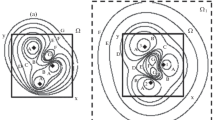Abstract
The decay of a strong magnetic field in a conducting matter is considered. It is shown that nondissipative Hall currents can considerably change the behavior of the field when it decays. The nonlinear character of the Hall effect leads to the generation of fields of high multipolarity even for most simple initial magnetic configurations. In particular, the evolution of an initially dipole configuration may give rise not only to quadrupole or higher poloidal harmonics but also to a toroidal field that is other than zero only inside the conductor. The nonlinear Hall currents relate different harmonics to each other and, in a sufficiently strong field, may provide efficient energy exchange between them. Due to this redistribution of the magnetic energy, the evolution of different harmonics has an oscillating character. The oscillation period is determined by the characteristic time of Hall drift and may be fairly short in strong magnetic fields.
Similar content being viewed by others
References
L. D. Landau and E. M. Lifshitz, Electrodynamics of Continuous Media (Nauka, Moscow, 1982; Pergamon, Oxford, 1960).
V. A. Urpin and D. A. Shalybkov, Zh. Éksp. Teor. Fiz. 100, 1272 (1991) [Sov. Phys. JETP 73, 703 (1991)].
S. Chandrasekhar and K. Prendergrast, Proc. Nat. Acad. Sci. 42, 5 (1956).
E. M. Lifshitz and L. P. Pitaevskii, Physical Kinetics (Nauka, Moscow, 1979; Pergamon, London, 1981).
A. Muslimov, H. Van Horn, and M. Wood, Astrophys. J. 442, 758 (1995).
T. Naito and Y. Kojima, Mon. Not. R. Astr. Soc. 266, 598 (1994).
V. Urpin and D. Shalybkov, Astron. Astroph. 294, 117 (1995).
A. Kingsep, K. Chukbar, and V. Yan’kov, Rev. Plasma Phys. 16, 243 (1990).
B. M. Askerov, Kinetic Effects in Semiconductors (Nauka, Moscow, 1970).
Author information
Authors and Affiliations
Additional information
__________
Translated from Zhurnal Tekhnichesko\(\overset{\lower0.5em\hbox{$\smash{\scriptscriptstyle\smile}$}}{l} \) Fiziki, Vol. 70, No. 2, 2000, pp. 6–11.
Original Russian Text Copyright © 2000 by Shalybkov, Urpin.
Rights and permissions
About this article
Cite this article
Shalybkov, D.A., Urpin, V.A. The Hall effect and oscillating decay of a magnetic field. Tech. Phys. 45, 147–152 (2000). https://doi.org/10.1134/1.1259587
Received:
Accepted:
Issue Date:
DOI: https://doi.org/10.1134/1.1259587



